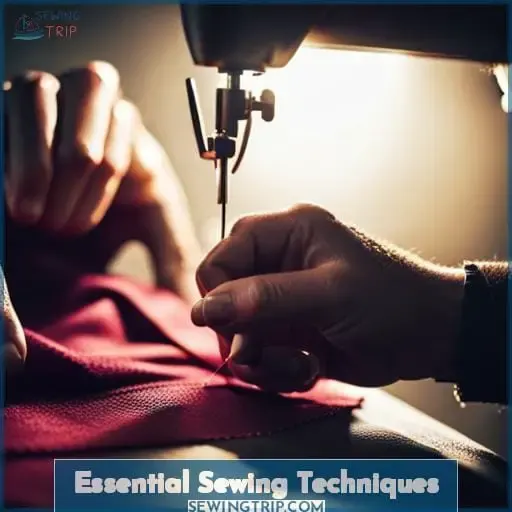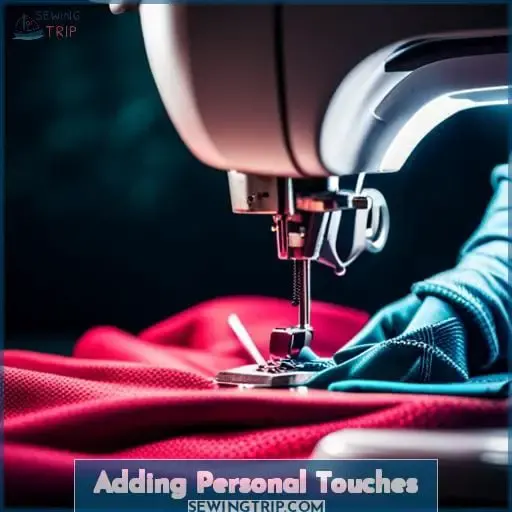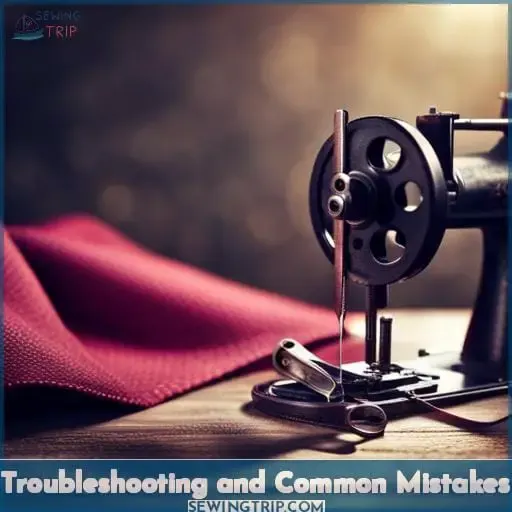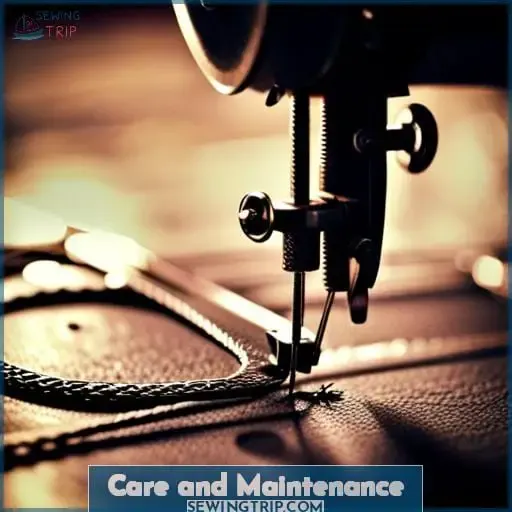This site is supported by our readers. We may earn a commission, at no cost to you, if you purchase through links.
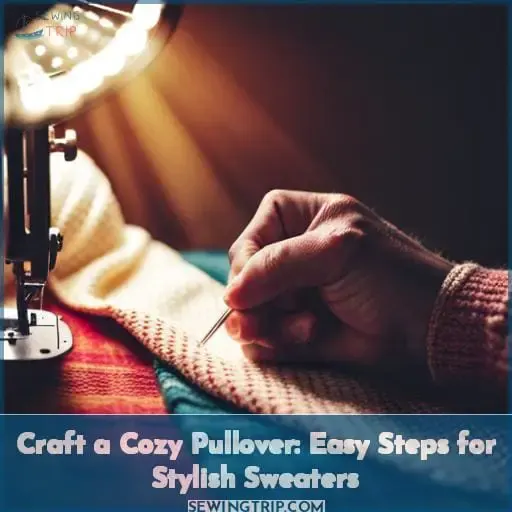 With over 200 million people knitting in the United States alone, clothing crafters can’t seem to get enough of soft, warm, and stylish sweaters.
With over 200 million people knitting in the United States alone, clothing crafters can’t seem to get enough of soft, warm, and stylish sweaters.
This step-by-step guide will teach you how to sew your own cozy pullover, from selecting the right fabric to adding unique touches that make it truly your own.
Pullover sewing is a skill that, once mastered, can empower you to create stylish sweaters for years to come.
Table Of Contents
Key Takeaways
- Fabric selection should consider stretch, weight, texture, and stretch and recovery properties.
- Essential sewing techniques involve preparing fabric and pattern pieces, sewing shoulder seams and sleeves, constructing side seams and hemming, pressing seams open, and topstitching along hems and cuffs.
- Finishing techniques include applying master finishing techniques, using French seams or a serger, exploring neckline variations, sewing quarter marks on cuffs and neckband, and considering fabric paint patterns and button embellishments.
- Adding personal touches involves crafting a pullover with embellishments, exploring color-blocking or pattern-mixing techniques, customizing a pullover, using appliqué designs, embroidery motifs, and beading accents, and employing fabric paint patterns and button embellishments.
Choosing the Right Fabric
When selecting your fabric, consider:
- Stretch: Choose fabrics with a good amount of stretch for a comfortable fit.
- Weight: Opt for a medium to heavyweight fabric for warmth.
- Texture: Consider the texture of the fabric as well; some fabrics, like fleece, are cozier than others.
Considerations for Fabric Selection (stretch, Weight, Texture)
- When choosing fabric for your pullover, consider:
- Stretch: Opt for fabrics with good elasticity for ease of movement.
- Weight: Select a weight appropriate for the desired warmth and drape.
- Texture: Consider the texture for a visually appealing finish.
- Colors and Patterns: Choose colors and patterns that complement your wardrobe.
- Durability: Select materials that can withstand repeated washing and wear.
Recommended Fabrics for Pullover Sewing Projects
When selecting fabric for your pullover, consider:
- Stretch and recovery: Choose fabrics with good stretch and recovery to prevent bagging or sagging.
- Weight: For a lightweight and breathable pullover, opt for fabrics like cotton jersey or bamboo rayon fleece. For a warmer and cozier pullover, choose fabrics like French terry or sweatshirt fleece.
- Texture: Consider the fabric’s drape and texture to achieve the desired look and feel for your pullover.
Tips for Working With Different Fabric Types
To ensure a professional finish, you’ll want to choose the right fabric for your pullover.
Consider the fabric’s properties like weight, drape, and texture.
Knits offer comfort and stretch, while wovens provide structure and stability.
Explore interfacing options to enhance fabric stability or add warmth.
Adjust seam allowances and patterns to suit your fabric choice.
Pre-treat fabrics to minimize shrinkage or color bleeding.
With the right fabric and preparation, your pullover will be a stylish addition to your wardrobe.
Essential Sewing Techniques
Now, you’ll tackle essential sewing techniques for crafting a professional-looking pullover.
Prepare the fabric and pattern pieces, ensuring accuracy in cutting and layout.
Sew the shoulder seams and attach the sleeves, paying attention to proper alignment and seam allowances.
Construct the side seams and hem the garment, using appropriate techniques for a neat and durable finish.
Steps to Prepare the Fabric and Pattern Pieces
Now that you’ve picked the perfect fabric for your pullover, let’s dive into preparing the fabric and pattern pieces, ensuring a smooth and successful sewing experience.
Cut fabric according to pattern pieces, marking seam allowances precisely.
Assemble pattern pieces, pinning fabric pieces right sides together.
Prepare your sewing machine with the correct stitch and needle.
You’re ready to sew, following the sewing guide for further instructions.
Sewing the Shoulder Seams and Attaching Sleeves
With preparation complete, sewing the shoulder seams and attaching sleeves requires careful alignment and precise stitching for a polished look.
Choose the right needle for your fabric to prevent skipped stitches or puckering.
Stitch the shoulder seams using a small seam allowance and backstitch at the beginning and end to reinforce the seam.
Attach the sleeves to the body, matching the notches and easing in any excess fabric.
Stitch the sleeve seams using a small seam allowance and backstitch at the beginning and end to reinforce the seam.
Constructing the Side Seams and Hemming the Garment
Stitch the side seams of your pullover, ensuring a straight and even seam allowance.
Serge or sew the edges to prevent fabric stretching.
Attach the hem band to the pullover, folding it in half lengthwise and sewing it to the wrong side of the garment.
Fold the hem band up and stitch it in place, creating a clean and finished look for your pullover.
Finishing Techniques for a Professional-looking Pullover
After hemming, apply master finishing techniques for a polished pullover.
Press seams open for a clean finish, and topstitch along the hems and cuffs for a professional touch.
For a durable garment, consider using French seams or a serger.
Explore neckline variations like a classic crew neck or a stylish cowl neck.
Sew quarter marks on cuffs and neckband for even distribution.
Adding Personal Touches
Craft your pullover with unique embellishments, pockets, or decorative stitching to make it distinctly yours.
Explore color-blocking or pattern-mixing techniques to create a visually striking design that reflects your personal style.
Let your creativity flow as you customize your pullover into a one-of-a-kind garment.
Ideas for Customizing the Pullover With Embellishments
Now that you have the basic pullover constructed, let’s dive into several creative ways to customize it with embellishments. Unleash your inner artist and transform your pullover into a unique masterpiece.
Appliqué designs, embroidery motifs, and beading accents can add intricate details. Fabric paint patterns and button embellishments offer pops of color and texture.
For a bolder statement, consider dyeing the fabric in vibrant hues or incorporating graphic designs.
Share your creative hacks and modifications with the community to inspire others.
Techniques for Adding Pockets, Zippers, or Decorative Stitching
Let’s explore techniques for personalizing your pullover:
- Strategically position pockets for both functionality and style.
- Integrate zippers for a touch of sleekness and ease of wear.
- Introduce decorative stitching patterns to elevate the pullover’s aesthetics.
Consider fabric compatibility and color combinations for a cohesive design.
Tips for Incorporating Color-blocking or Pattern-mixing
Take creative control of your pullover’s design.
Incorporate color-blocking or pattern-mixing to create a unique and eye-catching piece.
Explore color theory to understand harmonious combinations or use a color wheel for inspiration.
Experiment with different fabric choices to achieve varying textures and patterns.
Utilize a unisex pattern and free hoodie pattern for a versatile design.
Discover video tutorials and guides on how to sew a pullover with color-blocking or pattern-mixing techniques.
Unleash your creativity and make a pullover that truly reflects your personal style.
Troubleshooting and Common Mistakes
When sewing a pullover, challenges like uneven seams, puckering, or fabric stretching can arise.
To ensure a perfect fit, you may need to adjust the pattern.
Additionally, basting the fabric before sewing can help prevent puckering and distortion.
Solutions for Common Sewing Mistakes (uneven Seams, Puckering)
To fix uneven seams or puckering:
- Check your seam allowances.
- Adjust your machine’s tension.
- Use a seam ripper to carefully correct any errors.
- Opt for the right needle size to prevent fabric stretching and seam puckering.
Uneven hems can be fixed by:
- Adjusting the stitch length.
- Using a walking foot.
Skipped stitches often indicate a blunt or damaged needle, so:
- Replace it promptly.
Master these solutions and conquer common sewing hurdles with confidence.
Tips for Achieving a Perfect Fit and Adjusting the Pattern if Needed
Don’t let fit issues ruin your pullover. Learn how to adjust the pattern for a perfect fit.
Compare your body measurements to the pattern’s size chart.
Alter the pattern by:
- Adding or removing seam allowances
- Grading between sizes
- Making darts for a more contoured fit
Master these techniques to transform a basic pattern into a custom-tailored masterpiece that flatters your unique shape.
Dealing With Fabric Stretching or Distortion During Sewing
Managing fabric’s tendency to stretch or distort while you sew ensures a successful pullover.
Employ a stabilizer to reinforce stretchy fabrics, preventing unwanted distortion.
Strategically place interfacing to add structure and prevent sagging.
Use bias binding to encase raw edges, offering stability and a clean finish.
Maintain accurate seam allowances to ensure proper fit and avoid puckering.
Consider pattern alterations if the fabric’s properties demand a different fit.
Care and Maintenance
Proper care and maintenance extend the life of your pullover.
Follow the washing instructions on the garment’s label and use a gentle detergent.
To maintain its shape, lay the pullover flat to dry and avoid hanging it.
Instructions for Washing and Caring for the Finished Pullover
When laundering your cherished pullover, take extra care.
Use a gentle cycle and mild detergent.
Consult the label for optimal water temperature.
Dry the pullover flat or hang it to maintain its shape.
Store it neatly folded in a cool, dry place to prevent stretching or damage.
| Maintenance Task | Instructions | Considerations |
|---|---|---|
| Removing Stains | Blot fresh stains with a damp cloth. For older stains, use a mild stain remover. | Test the remover on an inconspicuous area first. |
| Repairing Holes or Tears | Use a sewing machine or fabric glue to mend small holes or tears. | Reinforce the area with a patch if needed. |
| Altering the Pullover | Take the pullover to a tailor or seamstress for alterations. | Consider altering the length, width, or neckline. |
Tips for Preserving the Fabric and Maintaining the Garment’s Shape
Nurture your pullover’s fabric and form:
- Hand-wash in cool water with mild detergent, avoiding harsh chemicals.
- Lay flat to dry, away from direct sunlight, to prevent fading and stretching.
- Store folded, not hung, to maintain its shape and prevent stretching.
Preserve your pullover’s softness and vibrancy:
- Use fabric softener sparingly.
- Address stains promptly with gentle stain removal techniques.
Suggestions for Storing the Pullover to Prevent Damage or Wrinkles
To keep your pullover looking its best, consider storing it folded or rolled, rather than hanging.
This reduces stretching and maintains its shape.
Use storage containers that protect against dust and moisture.
Control humidity levels to prevent fabric damage.
Employ moth prevention measures to safeguard your garment.
Garment bags offer an additional layer of protection and make it easy to transport your pullover.
Frequently Asked Questions (FAQs)
What are some creative ways to add embellishments or personal touches to a pullover, such as embroidery, appliques, or unique stitching techniques?
Unleash your creativity by personalizing your pullover.
Embroider vibrant designs, appliqué patches that tell your story, or use intricate stitching techniques to showcase your prowess.
Make it a reflection of your unique style and spirit.
What are some common mistakes to avoid when sewing a pullover, such as sewing the pieces together incorrectly or choosing the wrong fabric type?
Avoid fabric mismatches, incorrect pattern cutting, and direction changes during sewing.
Ensure proper fit by stretching fabric between pins when attaching bands.
What are some tips for sewing pullovers with different fabrics, such as lightweight knits, bulky sweaters, or stretchy materials, to ensure a professional-looking finish?
Master the art of crafting pullovers in diverse fabrics, from airy knits to cozy sweaters.
Embrace the challenge, harness your skills, and elevate your wardrobe with professional-looking garments that exude your unique style.
How can I prevent the fabric from puckering or stretching out of shape while sewing a pullover, especially in areas like the neckline or armholes?
Conquer fabric puckering and stretching with surgical precision.
Tame unruly necklines and armholes with expert techniques.
Master the art of garment construction, stitch by stitch, and unleash your inner couturier.
What are some general care and maintenance tips for pullovers, such as washing, drying, and storage, to ensure they retain their shape and quality over time?
Embrace gentle cycles, cool temperatures, and delicate detergents to preserve the pullover’s integrity.
Air-dry to prevent shrinkage and maintain shape.
Store neatly folded, not hung, to avoid stretching.
Conclusion
As you stitch the final seam, a sense of accomplishment washes over you like a warm wave.
You’ve created a cozy pullover that embodies your style and reflects your creativity.
Wearing your handmade sweater, you’ll feel the warmth of your accomplishment with every stitch, knowing you’ve mastered the art of pullover sewing.


